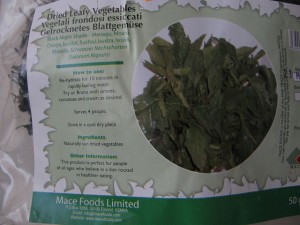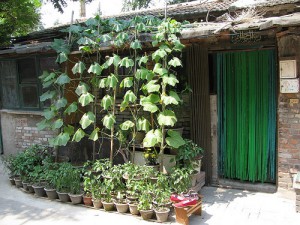- Science for the People blog carnival is up, answering questions.
- How fashion turns the local glamorous, exotic and desirable — foods edition.
- Sub-1 rice gene takes over local varieties, changes nothing except flood tolerance.
- Rhizowen may be suffering from inadvertent introgression, in his yacon.
- New variety — just the one — resistant to coffee berry rust and leaf rust released in Kenya.
Nibbles: Genebank, Guanaco, Maize, Wild food
- Maintaining a citrus gene bank. Just the book you need if you have to, er, maintain a citrus genebank.
- Guanacos need quiet.
- Don’t understand this piece on maize germplasm conservation and use.
- Indigenous food plants in trouble in the Philippines.
Nibbles: Ireland, Plumpy’nut, Saola, Food heritage protection, Millet, Wild veggies, Brassica, UNMDGs, Ukraine
- Celebrating the Irish Seed Savers Association celebrations. We had wanted to be there…
- CAS-IP on how to “break” the Plumpy’nut patent.
- Cattle wild relative seen for first time in 10 years. Well, by scientists anyway.
- “Initiatives that merely codify cultural products without taking the social-organizational context into account risk becoming little more than ‘museums of production.'” Ouch.
- Millet domestication pushed back in time.
- Antioxidant properties of traditional wild Iberian leafy greens. Yes, I know, this medicalizes nutrition, but I thought it was interesting that these wild species are still used.
- “…a trait of the diploid species, which apparently looks undesirable, might in fact be highly valuable for the improvement of amphidiploids…”
- “Food? We don’t need no stinkin’ food,” say UN negotiators.
- UK ambassador’s observations on agriculture in Ukraine. Love the contrast between 100 ha fields of sunflowers and the table groaning under home-grown fruit and vegetables.
- In other news, the UK’s ambassador to Ukraine has a blog. And so do a number of others. Sorely tempted to subscribe to their RSS.
On local greens and homegardens and local greens
![]() Great to see two papers by our friends at Bioversity come out in rapid succession recently relating to two project with which I was marginally connected in their early stages back in the 90s. One is on African leafy vegetables (ALV) ((Gotor, E., & Irungu, C. (2010). The impact of Bioversity International’s African Leafy Vegetables programme in Kenya Impact Assessment and Project Appraisal, 28 (1), 41-55 DOI: 10.3152/146155110X488817)), a common subject here. And the other on homegardens ((Galluzzi, G., Eyzaguirre, P., & Negri, V. (2010). Home gardens: neglected hotspots of agro-biodiversity and cultural diversity Biodiversity and Conservation DOI: 10.1007/s10531-010-9919-5)).
Great to see two papers by our friends at Bioversity come out in rapid succession recently relating to two project with which I was marginally connected in their early stages back in the 90s. One is on African leafy vegetables (ALV) ((Gotor, E., & Irungu, C. (2010). The impact of Bioversity International’s African Leafy Vegetables programme in Kenya Impact Assessment and Project Appraisal, 28 (1), 41-55 DOI: 10.3152/146155110X488817)), a common subject here. And the other on homegardens ((Galluzzi, G., Eyzaguirre, P., & Negri, V. (2010). Home gardens: neglected hotspots of agro-biodiversity and cultural diversity Biodiversity and Conservation DOI: 10.1007/s10531-010-9919-5)).
 The ALV paper tries to measure the impact of the work carried out starting in the mid-90s to identify and address key constraints to production and consumption. This is fairly easy to do in terms of research papers published and MSc degrees awarded, but more tricky when it comes to measuring what ALVs mean to the people who eat them. The authors tried to do this through fieldwork at four sites in Kenya. There’s no doubt there has been an increase in ALV production and marketing during the past 10 years, and a significant change in perceptions about these species, which are no longer considered simply “food for the poor.” Their presence in upmarket Nairobi supermarkets is testament to that. What still needs to be verified is that this is leading to significant nutrition and health benefits.
The ALV paper tries to measure the impact of the work carried out starting in the mid-90s to identify and address key constraints to production and consumption. This is fairly easy to do in terms of research papers published and MSc degrees awarded, but more tricky when it comes to measuring what ALVs mean to the people who eat them. The authors tried to do this through fieldwork at four sites in Kenya. There’s no doubt there has been an increase in ALV production and marketing during the past 10 years, and a significant change in perceptions about these species, which are no longer considered simply “food for the poor.” Their presence in upmarket Nairobi supermarkets is testament to that. What still needs to be verified is that this is leading to significant nutrition and health benefits.
A particularly poignant aspect of this study was the way it highlighted the importance of one person, the late Prof. James Chewya of the University of Nairobi, in driving the early ALV work, in particular by influencing young researchers to get involved. Jim is still much missed.
 The homegardens paper is less specifically tied in to the Bioversity project on this topic which began in the early 90s, being essentially a review of the literature of the past couple of decades. ((You can find a copy of the paper on Bioversity’s shiny new website.)) It rehearses the biological features of homegardens, in particular their complexity and diversity, stresses their cultural and socio-economic importance, and describes how these drive each other. The section on the future of homegardens as loci for research and conservation is especially interesting in its juxtaposition of the somewhat different roles of these intensive micro-environments in developing and high-income countries. ((I’ve removed the references in the following quotations to help the flow.))
The homegardens paper is less specifically tied in to the Bioversity project on this topic which began in the early 90s, being essentially a review of the literature of the past couple of decades. ((You can find a copy of the paper on Bioversity’s shiny new website.)) It rehearses the biological features of homegardens, in particular their complexity and diversity, stresses their cultural and socio-economic importance, and describes how these drive each other. The section on the future of homegardens as loci for research and conservation is especially interesting in its juxtaposition of the somewhat different roles of these intensive micro-environments in developing and high-income countries. ((I’ve removed the references in the following quotations to help the flow.))
In developing countries, the nutritional value of local, neglected horticultural species has been assessed and their cultivation in family gardens promoted to guarantee the intake of vitamins and micro-nutrients aiding in the control of HIV infections and other diseases. Establishment of food producing gardens, often based on local seed systems and traditional crops, in areas of explosive urbanization is becoming an important tool for making cities more sustainable while also providing marginal sectors of the population with working opportunities, healthier food and reinforcing their cultural identity.
Well, couldn’t you say much the same of the situation in the US and Europe?
In high-income countries the growing demand for healthier lifestyles and closer connection with nature has driven a renewed interest towards sustainable agricultural systems and ‘‘traditional’’ food products, capable of connecting consumers to the natural and cultural heritage of a community or a geographical region.
True enough, but the ALV experience in Kenya shows that this trend is not confined to places where Slow Food is active. Surely there is more scope for mutual learning.
If there’s one thing that disappointed me a little in reading through these two papers is the seeming lack of cross-fertilization between them. ALV are increasingly common in urban homegardens in Kenya. It would have been nice to see the lessons learned in the course of these two major projects brought together somehow. Maybe something along those lines is in the offing. I hope so. But that is to quibble. It is wonderful to see undervalued species, and the overlooked micro-environments where they often grow, coming into their own.
More on the great buckwheat panic of 2010

What really caught my eye in the article was this:
“It is believed that it was brought to Russia and further to Eastern Europe by Mongol Tatar invaders who first invaded China and knew what buckwheat was. In the Czech Republic for instance, it is called ‘pohanka’ — which means pagan or pagan’s food.”
The English name is supposedly derived from beech, whose seeds buckwheat’s resemble in miniature. But in Italian? Grano Saraceno. How about other languages?